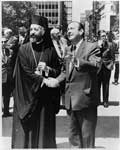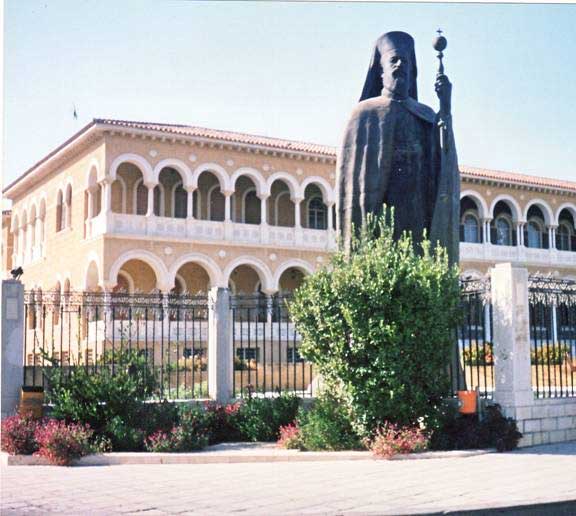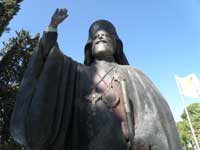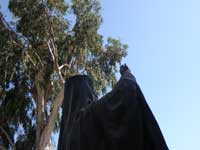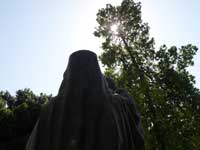.
Makarios III (Greek: Μακάριος Γ), born Andreas Christodolou Mouskos (Greek: Μιχαήλ Χριστοδούλου Μούσκος) (August 13, 1913 – August 3, 1977), was the archbishop and primate of the autocephalous Cypriot Orthodox Church (1950–1977) and the first President of the Republic of Cyprus (1960–1974 and 1974–1977).
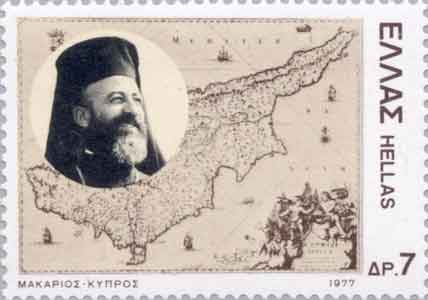
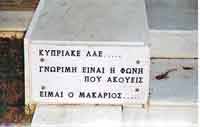
Early life, studies and Church career(1913-1950)
Michail Christodolou Mouskos was born in Panayia village in the Paphos District. In 1926, aged 13, he was admitted to Kykkos Monastery as a novice. At age 20 he was sent to the Pancyprian Gymnasium in Nicosia, where he completed his secondary education in 1936. He spent the difficult years of World War II studying theology and law at the University of Athens, graduating in 1942. He took up the duties of a priest in the Cypriot Orthodox Church while sustaining an interest in academic theology; he received a World Council of Churches scholarship to undertake further study at Boston University in Massachusetts.
1948, while still studying at Boston, he was elected Bishop of Kition. Mouskos adopted the clerical name Makarios and returned to Cyprus. Like many public figures in the Greek Cypriot community on Cyprus, in the 1940s and 1950s he was an active supporter of enosis, the union of Cyprus with Greece.
[edit] Enosis and EOKA (1950–1955)
On September 18, 1950, Makarios was elected Archbishop of Cyprus. In this role he was not only the official head of the Orthodox Church in Cyprus, but became the Ethnarch, de facto national leader of the Greek Cypriot community. This highly influential position put Makarios at the centre of Cypriot politics.
During the 1950s, Makarios embraced his dual role as Archbishop and Ethnarch with enthusiasm and became a very popular figure among Greek Cypriots. He soon became a leading advocate for enosis, and during the early part of the decade he maintained close links with the Greek government. In August 1954, partly at Makarios' instigation, Greece began to raise the Cyprus dispute at the United Nations, arguing for the principle of self-determination to be applied to Cyprus. This was viewed by advocates of enosis as likely to result in the voluntary union of Cyprus with Greece following a public plebiscite.
However, the British government were reluctant to decolonise the island which had become their new headquarters for the Middle East. In 1955, a pro-enosis organisation was formed under the banner of Ethniki Organosis Kyprion Agoniston (in English "National Organisation of Cypriot Fighters"), or EOKA. This was a typical independence movement of the period. Makarios undoubtedly had common political ground with EOKA and was acquainted with its leader, the Greek soldier and politician George Grivas, but the extent of his involvement is unclear and disputed. In later life he categorically denied any involvement in the violent resistance undertaken by EOKA.
Exile, escalation and Taksim (1955–1960)
Giant bronze statue of Makarios outside the Archepiscopal Palace in Nicosia. This landmark was moved to Kykkos Monastery in 2008 and replaced with a life sized statue [1]
On August 20, 1955, Greece submitted a petition to the United Nations requesting the application of the principle of self-determination to the people of Cyprus. After that, the colonial government of Cyprus enforced the anti-sedition laws for the purpose of preventing or suppressing demonstrations for freedom; but the archbishop defied them and continued demanding self-determination for Cyprus.
In October 1955, with the security situation deteriorating, the British governor, Sir John Harding, opened talks on the island’s future. By this stage, Makarios had become closely identified with the insurgency, and talks broke up without any agreement in early 1956. Makarios, characterised in the British press as a crooked Cypriot priest and viewed with suspicion by the British authorities, was intercepted by Special Branch officers whilst attempting to board a flight at Nicosia airport. The joint Police/Military plan, codenamed Operation Airborne saw Makarios exiled to Mahe Island in the Seychelles on 9 March 1956, as a ‘guest’ of Sir William Addis, Governor & Commander-in-Chief of the Seychelles. The Archbishop and his staff were flown to Aden and then on to Mombassa. At the Kenyan port the party were embarked in the East African Naval Vessel “Rosalind”, escorted by the frigate HMS “Loch Fada”. The flotilla arrived in Port Victoria on 14 March.
In the latter years of the 1950s, the Turkish Cypriot community first began to float the idea of Taksim or partition, as a counterweight to the Greek ideal of enosis or union. Advocates of Taksim felt that the Turkish Cypriot community would be persecuted in a Greek Cyprus, and that only by keeping part of the island under either British or Turkish sovereignty could the safety of the Turkish Cypriots be guaranteed. In this way the Cyprus dispute became increasingly polarised between two communities with opposing visions of the future of the island.
Makarios was released from exile after a year, although he was still forbidden to return to Cyprus. He went instead to Athens, where he was rapturously received. Basing himself in the Greek capital, he continued to work for enosis. During the following two years he attended the General Assembly of the United Nations where the Cyprus question was discussed and worked hard to achieve freedom for his people.
Under the premiership of Constantine Karamanlis in Greece, the goal of enosis gradually was abandoned in favour of Cypriot independence. Negotiations in 1958 generated the Zurich Agreement as a basis for a deal on independence, and Makarios was invited to London in 1959 to fine-tune the plan. Makarios at first refused to accept the plan. The reversal of his pro-enosis stance, and his eventual agreement to sign the conditions for the independence of Cyprus, have been attributed to moral persuasion on behalf of the Greek and British governments.
On March 1, 1959 the archbishop returned to Cyprus to an unprecedented reception in Nicosia, where almost two-thirds of the adult Greek Cypriot population turned out to welcome him. Presidential elections were held on 13 December 1959, in which Makarios defeated his rival, lawyer John Klerides, father of future president and Makarios ally Glafkos Klerides, receiving two-thirds of the vote. Makarios was to become the political leader of all Cyprus as well as the communal leader of the Greek Cypriots.
Primacy and presidency (1960–1963)
President Makarios in a state visit to Munich with the German Chancellor in 1962
After his election Makarios, together with the Vice-President-elect, Dr. Fazıl Küçük, continued to draw up plans for Cyprus’s future. By now, Makarios had accepted that enosis was not to be, and that the only outcome which could secure harmony in Cyprus was robust independence. Taking office on August 16, 1960, the day the Union Flag was finally lowered in Nicosia, Makarios moved towards the moderate centre of Cypriot politics and now pursued a policy of non-alignment, cultivating good relations with Turkey as well as Greece and becoming a high-profile member of the Non-Aligned Movement (NAM).
In March 1961, Cyprus was admitted as member of the Commonwealth of Nations and Makarios represented the island at the Commonwealth Prime Ministers' Conference. He attended the Belgrade NAM conference in September 1961, and unnerved the governments in London and Washington, D.C. with his lukewarm policy towards the West. This was seen in the U.S. as demonstrating a tendency towards communism[2]; Makarios was vilified as the "Castro of the Mediterranean"[3] although he had by now been rehabilitated in the British press and was affectionately nicknamed "Black Mak" on account of his clerical garb.
But the idea of an independent path for Cyprus had not taken root among the general public at home. There was increasing acrimony between Turkish and Greek Cypriots about the workings of the constitution, and Makarios was forced to act to salvage the machinery of state from imminent collapse. In November 1963, Makarios proposed thirteen amendments to the Constitution, which would free many public offices from the ethnic restrictions agreed in London and Zurich. This, he argued, would allow the government to operate more efficiently, and bring together the communities by dissolving rigid inter-ethnic legal boundaries. However, the Amendments were seen by many Turkish Cypriots as threatening constitutional protections against domination by the majority Greek Cypriots.
In response to Makarios' proposals, most Turkish Cypriots in public office, including Vice-President Küçük, resigned; large numbers of Turkish Cypriots moved out of ethnically mixed areas into villages and towns where the population was already largely Turkish Cypriot. There is still dispute over the motives for this, some arguing that it was made necessary by the intimidation of the Turkish Cypriots by the Greek Cypriots; others suggest that the Turkish community was sabotaging the Cypriot settlement and already preparing for partition by Turkey. By the end of 1963, intercommunal violence had broken out once again.
Makarios and the Cyprus problem (1964–1977)
The political landscape in Cyprus remained intractable. UN peacekeeping operations (UNFICYP) commenced in 1964 and helped to soothe, but not solve, the situation. Makarios continued his high-profile neutrality, but ultimately failed either to reassure the Turkish Cypriots that they were safe in an independent Cyprus, or to convince the Greek Cypriots that independence was a satisfactory alternative to assimilation within a Greater Greece.
President Makarios, seeking a fresh mandate from his constituency, announced in January 1968 that elections would be held during February. Makarios received 220,911 votes (about 96 percent), and his opponent, Takis Evdokas, who ran on a platform for unification with Greece, received 8,577 votes. Even though there were 16,215 abstentions, Makarios' overwhelming victory was seen as a massive endorsement of his personal leadership and of an independent Cyprus. At his investiture, the president stated that the Cyprus problem could not be solved by force, but had to be worked out within the framework of the UN. He also said that he and his followers wanted to live peacefully in a unitary state where all citizens enjoyed equal rights. Some Cypriots opposed Makarios' conciliatory stance (and there was an unsuccessful attempt to assassinate him in 1970).
In 1967, a military junta seized power in Athens, and the relationship between the regime and Makarios was tense. Makarios held that the regime undermined his authority by supporting paramilitary organisations committed to enosis.
In the summer of 1971, tension built up between the two Cypriot communities, and incidents became more numerous. Sometime in the late summer or early autumn, Grivas (who had attacked Makarios as a traitor in an Athens newspaper) returned secretly to the island and began to rebuild his guerrilla organisation, which became known as the National Organization of Cypriot Fighters (Ethniki Organosis Kyprion Agoniston B, aka EOKA B). Three new newspapers advocating enosis were also established; all of these activities were funded by the military junta in Greece.
The junta probably would have agreed to some form of partition similar to the Acheson Plan to settle the Cyprus question; however it faced rejection by Makarios. The overthrow of Makarios became the primary objective, and the junta backed Grivas toward that end. From hiding, Grivas directed terrorist attacks and propaganda assaults that shook the Makarios government , but the president remained both a powerful and popular leader.
Relations between Nicosia and Athens were so bad that the colonels of the Greek junta, recognizing that they had Makarios in a perilous position, issued an ultimatum for him to reform his government and rid it of ministers who had been critical of the junta. Mass demonstrations proved that Makarios had the people behind him. In the end, however, Makarios bowed to Greek pressure and reshuffled the cabinet.
Another element working against Makarios was the fact that most officers of the Cypriot National Guard were Greek regulars who supported the junta, and they embraced its desire to remove him from office and achieve some degree of enosis. Grivas also continued to be a threat to the archbishop. He remained powerful and to some extent was independent of the junta that had permitted his return to Cyprus. While the Greek colonels were at times prepared to make a deal with Turkey about Cyprus, Grivas was ferociously opposed to any arrangement that did not lead to complete enosis.
In the spring of 1972, Makarios faced an attack from another quarter. The three bishops of the Church of Cyprus demanded that he resign as president, stating that his temporal duties violated canon law. Makarios foiled the three bishops and had them defrocked in the summer of 1973. Before choosing their replacements, he increased the number of bishops to five, thereby reducing the power of individual bishops (see ecclesiastical coup).
As time progressed Grivas' pursuit of enosis through guerrilla tactics became an embarrassment to both Cyprus and Greece. However, his fame and popularity in both countries prevented his removal. Grivas died of a heart attack on January 27, 1974. Makarios granted his followers an amnesty, hoping that EOKA-B would disappear after the death of its leader. Intra-communal terror continued, however, and the 100,000 mourners who attended Grivas's funeral indicated the enduring popularity of his political aims.
On May 3, 1974, Makarios sent the Greek government a letter that identified certain Greek military officers stationed in Cyprus as undermining the Cypriot government. The Greek regime responded that it would replace the officers in question. In a second letter on July 2, 1974 he demanded the withdrawal of all Greek officers in the island. Greek Foreign Minister Tetenes suggested, as a compromise, that Makarios personally select the replacement officers from a roster of Greek officers. On July 11, Glafkos Klerides visited Makarios in an unsuccessful attempt to promote a solution. On July 15, 1974 the Greek regime sponsored a coup d'etat in Nicosia. Makarios fled and was replaced by Nikos Sampson, a Cypriot newspaper editor and politician.
While addressing the UN Security Council on July 19, 1974, Makarios accused the Greek military Junta of intervening in the internal affairs of Cyprus. Under the terms of the Treaty of Guarantee, Britain, Greece and Turkey were entitled to co-operate in order to intervene with the purpose of restoring the constitution of the island. Turkey used this as an excuse to invade and occupy part of the island.
At this time the Greek junta was imploding, and the British government was facing the constitutional uncertainty of a hung parliament; moreover, whilst in London, Makarios lobbied for the British military not to intervene as a guarantor power.[4] The invasion of Cyprus by Turkey occurred on July 20, 1974, five days after the coup. Northern Cyprus remains occupied by the Turkish Army, despite the constitution and presidency having been restored. To Turks and Turkish Cypriots it is known as a "peace operation", designed to protect the Turkish Cypriot community.
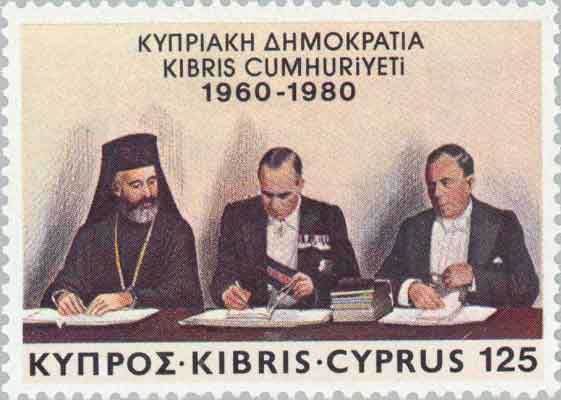
Nikos Sampson’s presidency was short-lived, as the regime in Athens collapsed only a few days after the Turkish invasion. Unsupported, Sampson fled, and the former constitution was restored. In the continuing absence of a vice-president, the presidency passed to the Speaker of the House of Representatives, Glafkos Klerides. Makarios remained in London for five months; then, having succeeded in securing international recognition that his administration was the rightful government of the whole island, he returned to Cyprus and focused solely on restoring Cypriot territorial integrity. He was not successful, and Turkey has remained as an occupying power ever since, with the situation continuing to be unresolved.
Death
Kykkos monastery, where Makarios started his ecclesiastical life and where his tomb now lies
Makarios III died unexpectedly, of a heart attack, on August 3, 1977. It has recently emerged that, in order to confirm the cause of death, Makarios' heart had been removed during an autopsy. The heart has since been preserved in his former bedroom in the Archbishopric.[5] He is buried in a tomb on the mountain of Throni, a site he personally chose. The tomb is near Kykkos Monastery, where he served as a novice in the 1920s and 1930s. To commemorate his life, an imposing bronze statue of Makarios was erected outside the Archbishop's palace in Nicosia; in 2008 the statue was moved to Kykkos monastery and replaced by a life-size marble statue of Makarios.
At his funeral, held at St. John's Cathedral outside the Archbishopric in Nicosia, 182 dignitaries from 52 countries attended whilst an estimated 250,000 mourners --about half the Greek Cypriot population of the island-- filed past the coffin.
Acclaim
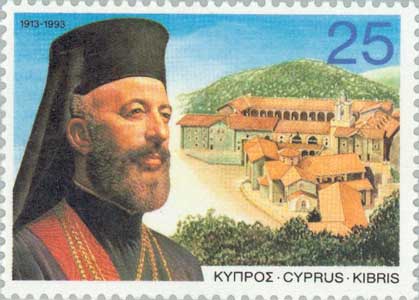
Makarios III
Orders and decorations
Grand Cordon of the Order of the Nile[6]
Special class of the Grand Cross of the Order of Merit of the Federal Republic of Germany[6]
Grand Master of the Order of Orthodox Hospitallers
See also
Foreign relations of Cyprus
Notes
^ Kambas, Michele (Thu Oct 23, 2008). "Cyprus axes "Big Mak" statue of first leader". Reuters. Retrieved 2008-10-24.[dead link]
^ "Turkey's Invasion of Greek Cyprus". GlobalSecurity.org. Retrieved 2008-10-09. "Makarios began to seek support among Greek Cypriots—especially those in the communist party—who rejected enosis, at least for the near future, in favor of an independent, nonaligned Cyprus."
^ "War in the Balkans, 1991–2002"
^ Ange S. Vlachos, Graduation 1974, Oceanis 2001 .
^ Markides, Constantine. "Macabre battle over Makarios’ heart". Cyprus Mail, November 16, 2006. Accessed 15 October 2008.
^ a b "Makarios' biography" (in Greek). Kykkos Monastery homepage. Retrieved 2008-04-26.
References
Christopher Hitchens, Cyprus, Quartet Books 1984
Glafkos Klerides, My Deposition, Alithia Publishing 1992
John Reddaway, Burdened with Cyprus: The British Connection, Weidenfeld & Nicolson 1986
P.N. Vanezis, Makarios: Faith & Power, Abelard-Schuman 1971
Ange S. Vlachos, Graduation 1974, Oceanis 2001
Nigel West (Rupert Allason), The Friends: Britain's Post-War Secret Intelligence Operations, Coronet 1990 (OP)
| Ancient Greece
Science, Technology , Medicine , Warfare, , Biographies , Life , Cities/Places/Maps , Arts , Literature , Philosophy ,Olympics, Mythology , History , Images Medieval Greece / Byzantine Empire Science, Technology, Arts, , Warfare , Literature, Biographies, Icons, History Modern Greece Cities, Islands, Regions, Fauna/Flora ,Biographies , History , Warfare, Science/Technology, Literature, Music , Arts , Film/Actors , Sport , Fashion --- |
Retrieved from "http://en.wikipedia.org"
All text is available under the terms of the GNU Free Documentation License

